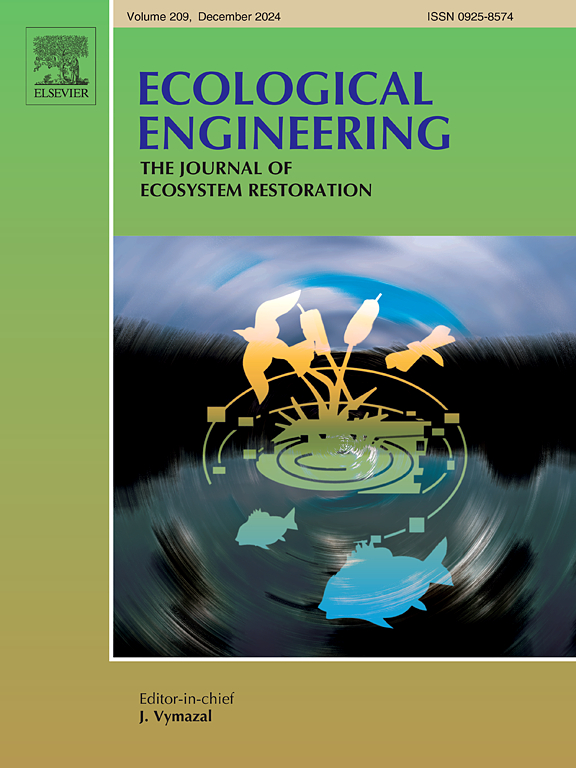量化生态修复项目的独立贡献——沂蒙山生态修复效果评价研究
IF 4.1
2区 环境科学与生态学
Q1 ECOLOGY
引用次数: 0
摘要
生态恢复项目(ERPs)对于促进区域可持续发展和提高社会福祉至关重要。然而,由于混杂因素的影响,它们对区域生态效益提升的独立贡献难以量化。本文以沂蒙山区域资源规划为例,构建了“模式-服务”层次评价框架,并引入了一种创新方法——时空差异中的空间差异法(STDM),即在资源规划评价前后插入两次空间差异,以隔离资源规划的独立贡献。结果表明:1)2020 - 2023年,沂蒙地区自然生态系统覆盖度增长6%,植被覆盖度增加20%,景观破碎化程度减少8%;2)主要生态系统服务功能(ESs)显著改善,其中防风蚀总量增长211%,涵养总量增长81%,蓄洪总量增长52%,水土保持总量增长47%。③项目实施范围内,生态资源规划的初始效应对植被覆盖度增加和水土保持改善的贡献率分别为72%和75%,对保水(28%)、防风(2.35%)和蓄洪(0.35%)的贡献率有限。本研究为评价ERP生态效益提供了有价值的方法论见解,为优化区域ERP实施提供了直接的启示。本文章由计算机程序翻译,如有差异,请以英文原文为准。
Quantifying the independent contributions of ecological restoration projects: An efficacy evaluation study of Yimeng Mountain
Ecological restoration projects (ERPs) are essential for promoting regional sustainability and enhancing societal well-being. However, their independent contributions to regional ecological efficacy improvement remain difficult to quantify due to confounding factors. To address this limitation, we present the Yimeng Mountain ERP as a case study and develop a “pattern-service” hierarchical evaluation framework, introducing an innovative method, spatial difference in temporal difference method (STDM) inserting twice spatial differences before and after the ERP assessment, to isolate independent contribution of ERPs. Key findings reveal that: 1) From 2020 to 2023, the Yimeng region experienced a 6 % growth in natural ecosystem coverage, a 20 % increase in fractional vegetation cover (FVC), and an 8 % reduction in landscape fragmentation. 2) Major ecosystem services (ESs) showed remarkable improvements, with the total amount of wind erosion prevention increasing by 211 %, water conservation by 81 %, flood water storage by 52 %, and soil conservation by 47 %. 3) The initial effect of ERP contributed 72 % of the FVC increase and 75 % of the soil conservation improvement within the project implementation scope, contributing to water conservation (28 %), wind erosion prevention (2.35 %), and flood water storage (0.35 %) were limited. This study offers valuable methodological insight for evaluating the ecological effectiveness of ERPs, providing direct implications for optimizing regional ERP implementation.
求助全文
通过发布文献求助,成功后即可免费获取论文全文。
去求助
来源期刊

Ecological Engineering
环境科学-工程:环境
CiteScore
8.00
自引率
5.30%
发文量
293
审稿时长
57 days
期刊介绍:
Ecological engineering has been defined as the design of ecosystems for the mutual benefit of humans and nature. The journal is meant for ecologists who, because of their research interests or occupation, are involved in designing, monitoring, or restoring ecosystems, and can serve as a bridge between ecologists and engineers.
Specific topics covered in the journal include: habitat reconstruction; ecotechnology; synthetic ecology; bioengineering; restoration ecology; ecology conservation; ecosystem rehabilitation; stream and river restoration; reclamation ecology; non-renewable resource conservation. Descriptions of specific applications of ecological engineering are acceptable only when situated within context of adding novelty to current research and emphasizing ecosystem restoration. We do not accept purely descriptive reports on ecosystem structures (such as vegetation surveys), purely physical assessment of materials that can be used for ecological restoration, small-model studies carried out in the laboratory or greenhouse with artificial (waste)water or crop studies, or case studies on conventional wastewater treatment and eutrophication that do not offer an ecosystem restoration approach within the paper.
 求助内容:
求助内容: 应助结果提醒方式:
应助结果提醒方式:


